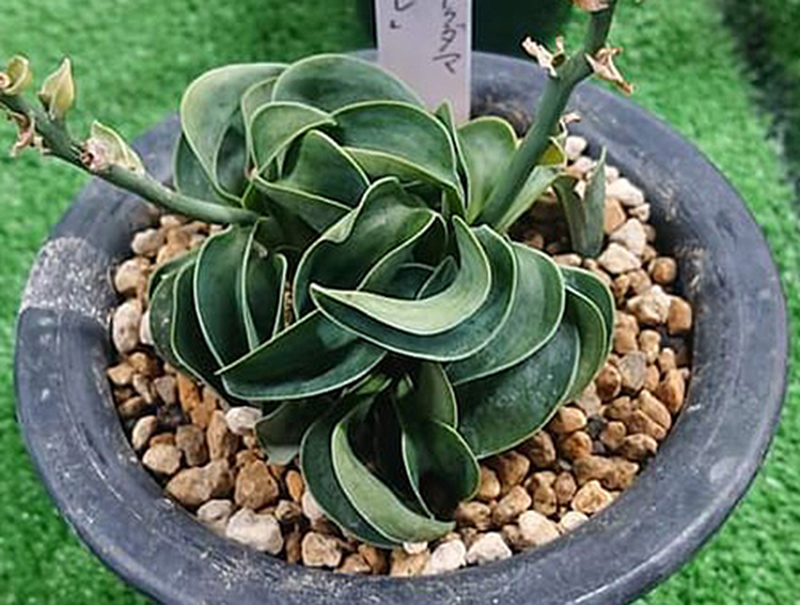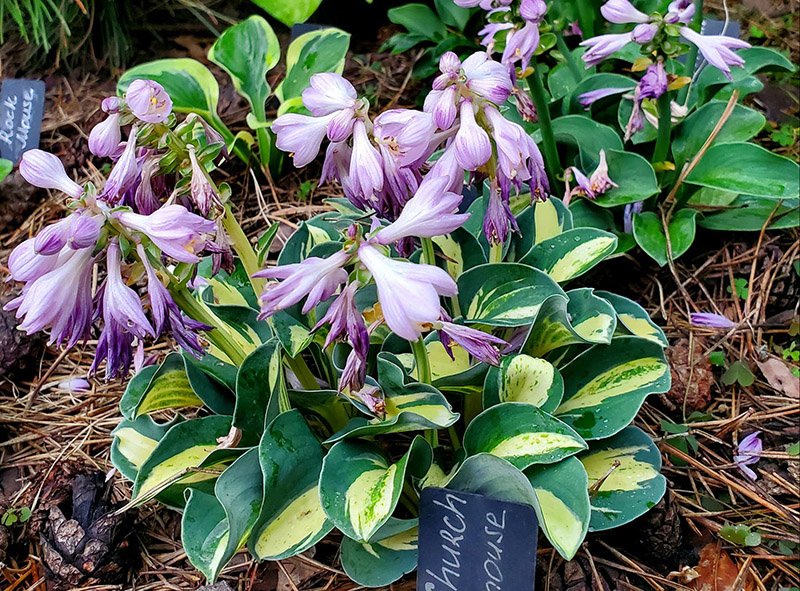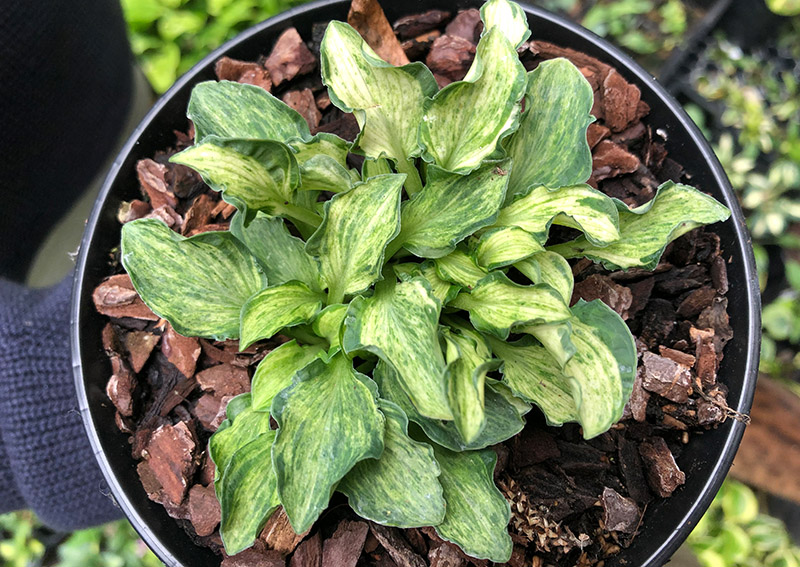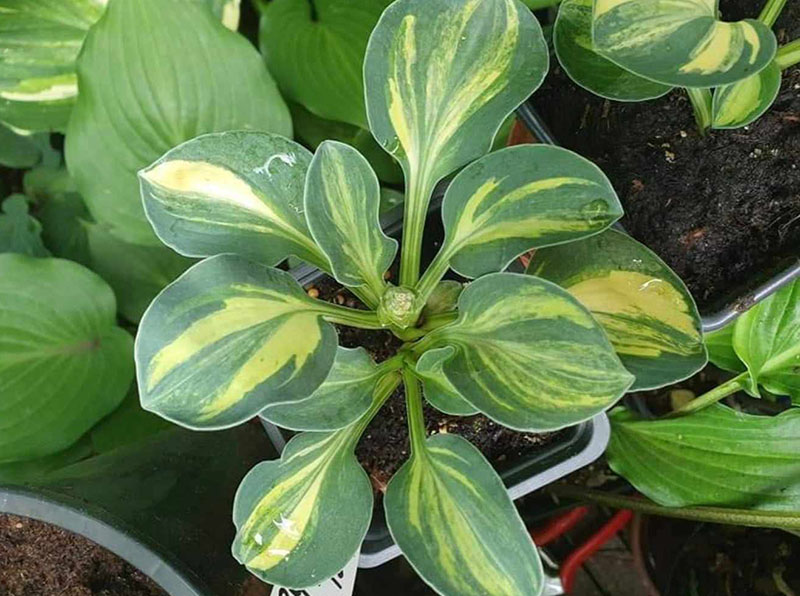The Magic of the 'Mouse' hostas | Text: Eurohosta + D. van Eeachaute + G. Veenstra, Foto: Eurohosta, D. van Eeachaute, G. Veenstra, Ch. Paulus, K. Samoilova, V. Mirka, Heemskerk Plants, Vision Pictures, A. Hall, V. Chaborek, J. Linneman, January 2024
|
BLOG: Did this article interest you? Read our other articles »»» |
||||
|
If you're a fan of small garden plants, a bonsai hobbyist, or someone who appreciates small rock garden plants, or maybe you are a cacti and succulent lover, you could appreciate the beauty of a small hostas from the group of 'Mouses'. The oldest and most famous cultivar from this group is hosta Blue Mouse Ears. It was registered by E. & J. Deckert in 2000. It is a charming and compact perennial that has captured the hearts of garden enthusiasts with its unique and delightful features. This miniature hosta, originating as a sport of Hosta ‘Blue Cadet‘, stands out for its distinctive appearance and garden-friendly characteristics. The leaves of hosta Blue Mouse Ears are the centerpiece of its allure. Resembling tiny mouse ears, they are small, thick, and distinctly blue-green in color, creating a visual treat for any garden setting. This distinctive foliage not only adds a touch of whimsy but also contributes to the plant's resilience, as it proves to be resistant against slugs and snails. The compact shape of this hosta makes it well-suited for a variety of garden spaces. Hosta ‘Blue Mouse Ears‘ typically reaches a height and spread of around 15 (h) to 25 (w) centimeters, forming neat, dense mounds that add texture and interest to borders, rock gardens, or container plantings. And you'll definitely love its lavender flowers, which are very large in comparison to the plant size. Thanks to its beauty and relatively low cost, this hosta cultivar has become one of the most demanded hostas in the world.
'Mouse' hosta mother - hosta ‘Blue Mouse Ears‘. The miniature world of 'Mouse' hostas Hosta ‘Blue Mouse Ears‘ has become the 'mother' of numerous equally enchanting cultivars. Despite these miniatures often being pricier than their parent Hosta Blue Mouse Ears, they have become some of the most sought-after cultivars in the world of miniature gardening. With more than 120 cultivars (we listen here 127 cultivars), introduced since hosta ‘Blue Mouse Ears‘ inception, 'Mouse' hostas are one of the largest groups inside the hosta cultivars family. We do not want to evaluate the quality of individual 'Mouse' hosta cultivars as it was not the purpose of this article. However, we must mention, that some of the cultivars that appear on our lists are not present anywhere in actual hosta collections. It is because the original plant no longer exists. Some cultivars referred to in the list were named without proper evaluation of their growing abilities. Some of them subsequently died because they have too little chlorophyll to stay alive independently, or from some other reasons. These include for example hosta ‘Ghost Mouse‘, hosta ‘Spooky Mouse‘ or hosta ‘Solar Mouse‘. Another problem that growers of these small perennials may encounter is the fact that sometimes they may be identical cultivars sold under different names. This could have happened for various reasons. For example, it's possible that for unknown reasons, someone sold an already named sport of the hosta Blue Mouse Ears under a different, new name. However, there are also other reasons. Generally, we can recognize three different types of 'Mouse' hostas. The first type - 'True Mouse' hostas includes hostas that are sports of Hosta ‘Blue Mouse Ears‘ or sports of the sports of hosta ‘Blue Mouse Ears‘ etc... These are generally very similar to hosta Blue Mouse Ears, especially in terms of their shape (leaves and mound). I would say these are 'True Mouse' hostas! Interestingly, some 'True Mouse' hostas do not even carry the 'Mouse' moniker, such as hosta ‘Mini Skirt‘, hosta ‘One Iota‘, hosta ‘Pure Heart‘, hosta ‘Baby Boo‘, and several others. Hosta 'Crazy Mouse Ears‘ is the collective name that Jim Schwarz used for various deviating TC sports from hosta ‘Blue Mouse Ears‘. So it is not a real cultivar but a name for a series of off-types. Here is the list of the 'True Mouse' hostas. They are all sports coming from hosta ‘Blue Mouse Ears‘. There are 98 cultivars, that we consider are 'True Mouse' hostas.
Family Tree of 'True Mouse' hostas - Part 1 (To find out the meaning of the numbers, see the References at the end of the article.)
Family Tree of 'True Mouse' hostas - Part 2 (To find out the meaning of the numbers, see the References at the end of the article.) The second group 'Semi True Mouse' hostas consists of hostas that are progeny of hosta ‘Blue Mouse Ears‘ or progeny of some of its sports. Or they are sports of these progenies. Some cultivars from this group have a shape similar to hosta ‘Blue Mouse Ears‘ , while others do not resemble it as much. We could say these are 'Semi True Mouse' hostas. We found information about 20 such cultivars. Blue Elf1 'False Mouse' hostas - the third and last group of 'Mouse' hostas includes some cultivars that are genetically quite distant from the original 'Mouse” hosta mother - hosta ‘Blue Mouse Ears‘. They are nor progeny nor sports of 'True Mouse' hostas, but they are often similar to them (it is not truth in several cases) or they have the word mouse in the name. These we would call 'False Mouse' hostas. Despite being genetically much different from hosta ‘Blue Mouse Ears‘, they can be habitually very similar. We found information about 9 such cultivars, however, several could be debated whether to include them here or not.
Hosta ‘Buffalo Ice Mouse‘. This is a beautiful and vital tissue culture sport of hosta ‘Blue Mouse Ears, which we found in our garden. We propagated it, registered it with the AHS in 2020, and it has been available to our customers since 2024.
Hosta ‘Desert Mouse‘ comes from the Netherlands and is among the most beautiful 'True Mouse' hostas. Renowned grower Jan van den Top from Netherlands patented this cultivar, and he did well because it is a highly popular hosta.
Hosta ‘Frosted Mouse Ears‘ reached Europe from America, where Mark Zilis/Emile & Jane Deckert registered it in 2006. It is a tissue culture sport of hosta ‘Royal Mouse Ears‘, growing well and being vital.
Hosta ‘Royal Mouse Ears‘ usually belongs to the rarest gems in 'Mouse' hosta collections. It grows very slowly and is not very vigorous in our conditions.
Hosta ‘Buffalo Misty Mouse‘. This is a highly unstable, variegated cultivar. Every time we try to propagate it, the result is a blue-green, solid-colored hosta. Currently, two plants have left our garden. Its instability in our garden is why we did not register this cultivar. Variegation is very inconspicuous in spring, becoming more creamy and visible later in the season.
Hosta ‘Japanese Mouse‘ comes from Japan, known there as 'Nezumi-Gaeshi'. We decided to introduce it to the European market as 'Japanese Mouse' due to its resemblance to small hostas often referred to by collectors as 'Mouse' hostas. Hosta Japanese Mouse‘ has small, cute leaves twisted to the sides, resembling mouse ears. This hosta is particularly suitable for container gardening and is easy to grow. If you are a fan of small hostas, Japanese Mouse should be a part of your collection!
Hosta ‘Lucky Mouse‘ is the 'sister' of Hosta ‘Desert Mouse‘ but with reversed coloring. Another cultivar from the Netherlands introduced by Jan van den Top.
Hosta ‘Mouse Capades‘ is among the newer 'True Mouse' hostas. Registered by Rob Mortko in the USA in 2013, it quickly made its way to Europe. It is characterized by good growth.
Another cultivar from America – hosta ‘Mouse Trap‘. Registered by Shady Oaks Nursery. A very nice and vigorous hosta. Occasionally reverts to the original form (not too intensely), but with a bit of care, this is not a serious problem. Green shoots need to be removed.
Jan van den Top registered hosta ‘Ruffled Pole Mouse‘ as a sport of hosta ‘Green Mouse Ears‘. It belongs to the 'True Mouse' hostas, but its leaves are so different. They are narrow and no longer resemble mouse ears. Nevertheless, it is a very pleasant hosta that will certainly find a place in any 'Mouse' hostas collection.
Hosta ‘Smiling Mouse‘ is another hosta from Jan van den Top. It comes from hosta ‘Frosted Mouse Ears‘. It grows well and does not tend to revert to a solid form.
Hosta ‘Mouse Party‘ is one of the most beautiful variegated sports from hosta ‘Blue Mouse Ears‘. It comes from Belgium introduced by Danny Van Eechaute (well known to introduced many nice hosta ‘Blue Mouse Ears‘ sports) and is a highlight in any hosta collection.
Container gardening is the most used method of growing mice...
Sport from hosta ‘Blue Mouse Ears‘ hosta ‘Botters Popeye‘ is maybe a triploïde.
Hosta ‘Sun Mouse‘ is a 'semi true' mouse hosta.
Hosta ‘Mighty Mouse‘ was registered in US by Walters Gardens Inc. It is a sport of hosta ‘Blue Mouse Ears‘.
Hosta ‘Holy Mouse Ears‘ is a nice sport from hosta ‘Royal Mouse Ears‘ registered in US.
Hosta ‘Mouse Aquarel‘ is a sport from ‘Danish Mouse‘.
Rare hosta ‘Arctic Mouse‘ from D. van Eechaute from Belgium.
Hosta ‘Screaming Mouse‘ is a rare streaked hosta sport from hosta ‘Macho Mouse‘.
Hosta ‘Ruffled Mous Ears‘ is a sport of hosta ‘Blue Mouse Ears‘. Growing tips for 'Mouse' hostas Enough light is an important factor for this series of Hostas. The hosta has the reputation of being a shade plant. However, this is only the case in a few instances. Most hostas grow well in partial shade. The hosta ‘Blue Mouse Ears‘ series, in particular, needs enough light. They do their best in a spot with half sun to 3/4 sun exposure, in combination with sufficient water. Most collectors have their 'Mouse' treasures in pots, just like bonsai, cacti, or succulent growers. Although beds provide better opportunities for growth and maintenance of soil moisture, on the other hand, there can be a problem with weeds and other plants that easily compete with small 'Mouse' hostas. If you ensure good moisture and light management in the pot, most cultivars are undemanding and grow well, bringing you joy and delight throughout the whole season. One issue in container planting is that certain mice quickly overtake the container and require more frequent repotting compared to other hosta varieties. Another potential problem is instability and the tendency for certain mice, especially the Blue Mouse Ears sports, to revert to their original green-blue form. This trend is evident in cultivars like ‘Snow Mouse‘, ‘Desert Mouse‘, ‘Mouse Trap‘, and generally in most of those having a light center on the leaves. Cultivars with a green or blue-green center of the leaves are less prone to reversion. The highest instability and tendency to reversion are usually seen in streaked cultivars. Reverted buds should be regularly removed manually. Another significant challenge, important for breeders, is the sterility of most cultivars. This makes hybridization of 'Mouse' hostas difficult, as they are generally not suitable for breeding purposes. While there may be some exceptions and occasional seeds are produced, the majority of cultivars remain sterile. 'Mouse' hostas as collector’s plants Considering the beauty of these small perennials, it is no surprise that they have attracted the attention of gardeners all over the world, and groups of enthusiasts have emerged who are dedicated to collecting these cultivars. However, getting them into the hosta collection may not be easy at all. Although some cultivars have a lower price, most of them belong to the more expensive perennials. This is mostly related to the fact that not all 'Mouse' hosta cultivars have been propagated through tissue culture (TC), and so their price still remains relatively high. The most expensive cultivars are those with variegated leaves. They are unstable – that is, they tend to revert to their parents, so their cultivation and propagation is the most complicated of all. Some cultivars exist only in the private collections of hybridizers, never to be offered for general sale. However, nothing deters 'Mouse' hosta collectors, not even the difficulty of cultivation, high price, or other circumstances (some American cultivars are not and have never been available, for example, in the EU and vice versa), to build their hosta collections of this group. 'Mouse' hostas bring a delightful mix of excitement, pleasure, and joy, along with the challenge and potential for uncovering hidden gems. As the season progresses, 'Mouse' hostas will grace your garden with a variety of colors and later a flood of profuse flowering. Their ability to create new sports gives you hope that you too will one day discover a new, unexpected gem in your collection that you might name someday. Growing 'Mouse' hostas is not only about size and shape; it's also about diversity and surprises. For all these reasons, 'Mouse' hostas have captured the hearts of many garden enthusiasts. In our offering, you will find about 30 'Mouse' hosta cultivars that are available from time to time... For more information about 'Mouse' hostas check the references.
Hosta ‘Cool Mouse is a sport from the hosta ‘Mouse Party.
Extra rare hosta 'Valley's Mouse Tail'.
"Mouse" garden... References 1 - Hostalibrary © This text and photos are protected by intellectual property rights under the Law no. 618/2003 Coll. (the Copyright Act). |
||||
|
BLOG: Did this article interest you? Read our other articles »»» |





































